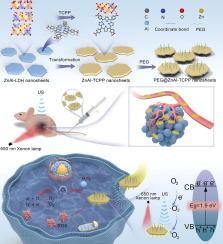2D MOFs nanosheets derived from 2D LDHs as a multifunctional sensitizer for sono-photodynamic therapy-mediated tumor treatment
IF 13.3
1区 工程技术
Q1 ENGINEERING, CHEMICAL
引用次数: 0
Abstract
Sono-photodynamic therapy (SPDT) has been proposed as a new cancer treatment modality to compensate the shortcomings of limited tissue penetration depth of light in photodynamic therapy (PDT) and low reactive oxygen species (ROS) generation efficiency in sonodynamic therapy (SDT). However, the lack of favorable sensitizers with efficient PDT and SDT properties as well as high ROS yield remains a significant challenge in achieving superior therapeutic outcomes for superficial and deep tumors. Herein, we first report the construction of two-dimensional (2D) ZnAl-TCPP metal organic framework (MOF) nanosheets using ZnAl-layered double hydroxide (ZnAl-LDH) nanosheets as a precursor through phase transformation strategy for highly efficient SPDT. ZnAl-LDH nanosheets are pre-synthesized by bottom-up method and then transformed into ZnAl-TCPP nanosheets via a hydrothermal treatment with TCPP ligands. Surprisingly, ZnAl-TCPP nanosheets exhibit excellent ROS-generating activity under both light and US irradiation, which is superior than either light or US irradiation alone, demonstrating its synergistic effect for SPDT. More importantly, the ROS generation activity of ZnAl-TCPP nanosheets outperforms TCPP (3.0 times), which may be attributed to the phase transformation from LDH to MOF resulting in the decrease of bandgap, the generation of defects, and the coupling effect between heterometallic centers that sensitize TCPP ligands. After modification with polyethylene glycol (PEG), ZnAl-TCPP-PEG induces strong oxidative stress under light and US irradiation, which causes significant mitochondrial and lysosomal damage, thus leading to cell apoptosis and tumor growth inhibition.

由二维LDHs衍生的二维mof纳米片作为声光动力疗法介导的肿瘤治疗的多功能敏化剂
声光动力疗法(SPDT)作为一种新的癌症治疗方式被提出,以弥补光动力疗法(PDT)中光穿透组织深度有限和声光动力疗法(SDT)中活性氧(ROS)生成效率低的缺点。然而,缺乏具有高效PDT和SDT特性以及高ROS产率的有利增敏剂仍然是实现浅表和深部肿瘤良好治疗效果的重大挑战。本文首次报道了以znal层状双氢氧化物(ZnAl-LDH)纳米片为前驱体,通过相变策略构建二维(2D) ZnAl-TCPP金属有机骨架(MOF)纳米片,用于高效SPDT。采用自下而上的方法预合成ZnAl-LDH纳米片,然后用TCPP配体水热处理转化成ZnAl-TCPP纳米片。令人惊讶的是,ZnAl-TCPP纳米片在光和US照射下都表现出优异的ros生成活性,优于光或US单独照射,证明了其对SPDT的协同效应。更重要的是,ZnAl-TCPP纳米片的ROS生成活性优于TCPP(3.0倍),这可能是由于从LDH到MOF的相变导致带隙减小,缺陷的产生,以及异质金属中心之间的耦合作用使TCPP配体敏化。ZnAl-TCPP-PEG经聚乙二醇修饰后,在光和US照射下引起强烈的氧化应激,导致线粒体和溶酶体明显损伤,从而导致细胞凋亡和肿瘤生长抑制。
本文章由计算机程序翻译,如有差异,请以英文原文为准。
求助全文
约1分钟内获得全文
求助全文
来源期刊

Chemical Engineering Journal
工程技术-工程:化工
CiteScore
21.70
自引率
9.30%
发文量
6781
审稿时长
2.4 months
期刊介绍:
The Chemical Engineering Journal is an international research journal that invites contributions of original and novel fundamental research. It aims to provide an international platform for presenting original fundamental research, interpretative reviews, and discussions on new developments in chemical engineering. The journal welcomes papers that describe novel theory and its practical application, as well as those that demonstrate the transfer of techniques from other disciplines. It also welcomes reports on carefully conducted experimental work that is soundly interpreted. The main focus of the journal is on original and rigorous research results that have broad significance. The Catalysis section within the Chemical Engineering Journal focuses specifically on Experimental and Theoretical studies in the fields of heterogeneous catalysis, molecular catalysis, and biocatalysis. These studies have industrial impact on various sectors such as chemicals, energy, materials, foods, healthcare, and environmental protection.
 求助内容:
求助内容: 应助结果提醒方式:
应助结果提醒方式:


